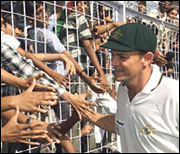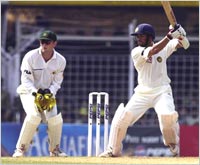

Aussies make it 16 on the trot
Prem Panicker
This match report can be written in two words: abject surrender!
That India lost need not hurt, at least, too badly. That India's vaunted cricketers did not fight, that they caved in, in the most spiritless fashion imaginable, will have hurt everyone who had the misfortune of watching the side cave in inside three days, on their own home ground.
When the Indians returned from Australia, many players in off-record conversations expressed anger at having been done in by bad umpiring and rampant Australian aggro. The same players, too, expressed a determination to pay the Aussies back when it was their turn to come over here.
Yet, when the chance finally came their way, only one Indian proved himself even remotely capable of walking that talk. The others, without exception, played sans heart, sans courage, sans spirit -- and Australia took its first giant step towards conquering what Steve Waugh called the Final Frontier.
The third day was packed with possibilities -- and the morning session produced a very good example of real Test cricket. A testing pitch with life for pace and spin alike, a four-pronged lineup of quality attacking bowlers, two highly skilled batsmen engaged in a fightback -- the morning had everything going for it.

The bowling was uniformly good, with variety, control, testing lines and variations. The batting, equally so as Sachin Tendulkar and Rahul Dravid countered everything thrown at them in their own individual styles.
Dravid, as always, preferred the patient, anchoring role and played it with his usual competence. You could in critical vein make the point that he could have taken more singles and rotated the strike, thus not allowing a bowler to work on him for any length of time -- but then, in a tight situation, it is equally true that every batsman would be well advised to stick to what he does best.
Tendulkar, equally, displayed patience while playing the waiting game, yet sufficient alertness to pounce on every error in line and length and hitting with power and timing.
The first mission for the Indians had to be to ensure that the morning's helpful bowling conditions were negated -- and by going in to lunch unseperated, Dravid and Tendulkar accomplished that. India went in to the break on 116/2.
Post lunch, Tendulkar shifted gears. He had patiently batted India into a position where the Australian lead was just a few strokes away from being neutralised. Thus, during the session after lunch when, traditionally, the Wankhede is most friendly to batsmen, he began a counter-attack. Jason Gillespie was the first casualty as Tendulkar drove him to distraction and, on one occasion, to open anger, a smashing pull prompting the fast bowler to mouth a few words.
Next up for treatment was Shane Warne. And around this time, it became apparent to all -- except the batsman concerned, that is -- that Dravid's tendency to lock himself into one mindset was getting him into trouble. Dravid defending in the morning was sensible. Doing the same, when batting was at its easiest, allowed the Aussies to button things down at one end -- compare that to the partnership between Hayden and Gilchrist, when the latter played the aggressor and Hayden supported him with constant strike rotation, and you will understand where the problem was coming from.

Sachin, meanwhile, was turning his attention to Mark Waugh. A spanking drive told the part-time off spinner that bowling the line outside off wasn't going to do it. And when Mark Waugh dropped short, Sachin swiftly rocked back and pulled. It fetched him four. The same bowling error, a ball later, produced another of those fortuitous dismissals that have been Tendulkar's bane. Sachin pulled, with enormous power. Langer, at short square leg, turned his back and ducked. The ball thumped into him, high on his back, and bounced. Ricky Ponting, alert as always at shortish mid on, raced around to midwicket, then dived headlong, and produced a catch of incredible brilliance to end Tendulkar's innings.
Out came Sourav Ganguly -- easily India's best player of spin, and best hitter of the long ball. The stage seemed perfect -- the ball was old, the spinners were on at both ends, there was no possibility of McGrath and Gillespie getting into the action in the immediate future. And yet, Ganguly opted, in a replay of his first innings style, to keep pushing his pad at the ball. When a top spinner almost produced the edge, Ganguly promptly essayed a wild swipe, head high in the air, at the next ball. Off the toe of the bat, the ball went well to the left of Michael Slater at midwicket. The two batsmen went into their yes-no routine, Ganguly first responded, then for no evident reason checked, then ran -- and was hopelessly out of his ground when the throw came in.
If the incident was schoolboyish, what followed was unworthy of an international cricketer who is also the captain of the side. Ian Chappell, then in the commentary box, said it best: "If you aspire to lead men, you never, ever, blame them in public." Ganguly, unfortunately, appears not to have learnt that lesson -- as he walked off, the cameras clearly caught him mouthing imprecations aimed at his vice-captain. What that is likely to do, for team spirit, and for the kind of cohesion you expect between the captain and his deputy, is anyone's guess.
VVS Laxman will need to look deep within himself, and answer one question -- is he, like say a Vinod Kambli, another of those players who is too good at the domestic level, but not good enough for the top? One straight drive off Warne, and the cover drive that followed, were stamped with class -- but the attempt to cut a ball too close to his stumps, more so on a turn that was affording bounce, was not. The edge was inevitable, and Gilchrist held it with ease.
Rahul Dravid, as mentioned before, needs to learn to hold two ideas in his head at the same time. Thus, defending and playing long sessions is certainly the right thought -- but at the same time, there has to be the alertness to seize every scoring opportunity that the bowling affords. Not doing this puts pressure -- on himself, even more than on his partner. And that pressure produces his downfall, time and again.
Today was yet another example -- having played 190+ deliveries for very little runs against his name, having spent all morning and a good bit of the afternoon padding away deliveries outside leg stump, Dravid suddenly realised that he needed to score some runs as well. And opted to try and paddle the one ball he should not have played that shot to -- a Warne delivery angled across on a full length outside leg, and spinning viciously. Dravid's bat and pad went down the wrong line on the paddle, the ball pitched outside leg, bit into the turf, turned, and took out the off stump.
Ajit Agarkar added another record to his collection -- a wild heave that saw his middle stump uprooted put the seventh successive duck against his name, against the Australians.
Mongia meanwhile played the spinners combatively, time and again hitting, and hitting well, over the top. Gillespie, the man who injured him in the first innings, was brought back with the new ball -- and Mongia immediately gave up the fight. The first ball saw him stepping almost on square leg's toes and slashing. That one connected. Another slash missed, the ball whistling a centimetre over the stumps. Yet another slash, to a short one going down leg side -- note, the ball was going over the stumps, outside leg, and Mongia had gone so far down the leg side that he was still outside the line -- saw Gilchrist take. And Mongia, much to everyone's surprise, began walking.

There had been only a half-hearted, knee-jerk, appeal by Gilchrist. The bowler had made a moue of disgust, at not getting the edge, and turned round to walk back to his bowling run, when he saw Venkatraghavan putting his finger up in reaction to Mongia's walk. And that tells its own tale, as far as attitude is concerned -- for the Indian keeper, it was too hot to stay in the kitchen, and he didn't care who knew it.
Gillespie then produced a ball of fullish length, going round the wicket, to go through Sanghvi's defences. Srinath came in last, to parody cricket, playing with just one hand. It made you wonder why, if he was so clearly unable to hold the bat in both hands, he was sent out at all -- surely the Indian captain and management didn't imagine he would bat out the remaining two days and fetch a draw? If he is in fact badly injured, as his antics with the bat clearly indicated, then where lay the sense in aggravating that injury by going out there?
McGrath produced a slow yorker, and Srinath obliged, to end India's innings on 219, leaving Australia 47 to get to win.
The final few minutes produced even more comedy. The only thing the Indians could hope for was the tenuous psychological edge to be gained by putting a ring of fielders around the bat, and getting Slater and possibly one or two of the others out cheap. Instead, we were subjected to the edifying spectacle of a field well spread out -- surely, no one in his right mind imagines it is actually possible to defend a target of 46?
Thus, Slater merrily edged to third slip, and got four because there was no third slip. Hayden, much impressed, duplicated that shot. Then Slater, probably to prove that he knew more than one trick, edged the off spinner to the slip cordon -- and after the catch had gone to waste because there was a gap between the sole slip and the silly point, a gully was put in place.
It was all rather perplexing. Fortunately for those too intellectually challenged to understand what was going on, Slater and Hayden made short work of the target, and Australia wrapped it up with two days and more, not to mention ten wickets, to spare.
A question needs addressing -- the pitch. A section of the Indian team has been sulking about it from day one, and it needs pointing out, and firmly at that, that those sulks are misplaced. The pitch had life for seamers -- ask McGrath and Gillespie. So if the Indian seamers couldn't duplicate the performance of the Aussies, it is not the pitch that is to blame. The pitch had turn and bounce for the spinners -- ask part time off spinner Mark Waugh. So if India, having asked for a turning track and getting one that turned square, opted to go in with two spinners instead of three, the pitch is not to blame. If the Indians put down four catches, no blame can stick to the pitch. If tactics are so infantile that, against two left-handers intent on sweeping like municipal employees on overtime pay, there is no midwicket in place, that is not a fault of the wicket. And if batsmen couldn't make runs, again, it is not the fault of the pitch -- ask the likes of Hayden, Gilchrist, and Tendulkar.
It takes good cricket to win Tests -- if it were all to be left to the pitch, then the curator should be getting the applause, the awards, and the endorsements.
The Aussies, for their part, deserve congratulations in full measure. Time and again they were pushed on the backfoot, time and again they hung on grimly, waited for the tiniest opportunity, and fought back fiercely. They showed why they win -- because they will not accept anything less, will not settle for anything less. And they fully deserved this victory -- and the standing ovation the Mumbai crowd gave them at the end.
The crowd, in fact, had earlier given first Gilchrist, then Hayden, similar ovations when they walked back after their displays of batsmanship. It is a pity, then, that Michael Slater had to spoil what would have been a perfect outing, with a childish display.
In the morning session, Dravid pulled a short ball from Fleming and Slater, at midwicket, dived headlong to come up with the ball and appeal.
So far, so good.
On the replay, it showed that while Slater had got his fingers under the ball, he hadn't managed to cup his hands, with the result that the ball touched the ground. No way Slater could have known that -- diving headlong in front can jolt you as chest hits turf, and you are therefore not in a position to follow the ball that closely. So, first up, you can't quarrel with Slater claiming the catch.
The onfield umpire referred it to the third umpire. Again, fair enough -- no way Venkat, officiating, could have judged the fairness and since the third umpire is there to help out in just such situations, Venkat was within his rights to call him in.
The third umpire, with benefit of action replay, ruled Dravid in -- again, the right decision.
What happened next produced a shock, and raised several questions. Slater, on seeing the green light go up, stormed up to umpire Venkatraghavan and heatedly argued, claiming that the catch was fair.
Question one: Given that the code of conduct forbids you from questioning a decision, how could Slater argue with the umpire? Two, what is the point of arguing with the on-field umpire over a decision made by the third umpire? Surely, Slater didn't expect Venkat to overrule the third umpire, who has the benefit of video replays, and take his word for the fairness of the catch?
If that was bad, then what followed was worse -- Slater then stormed up to Dravid and heatedly told him to walk, arguing that his catch was fair. First up, the umpire's decision had been given, arguing with Dravid was the height of stupidity. Secondly, Slater in the first innings was clearly out nicking behind, yet stood his ground when Umpire Shepherd ruled him in -- and given that, had no moral right to ask Dravid to walk anyway.
If asking Dravid to walk was bad enough, the accompanying language was worse. And where the need lay for McGrath, fielding peacefully on the square leg fence, to come walking briskly in and add a few words of his own to Dravid, only the Aussie quick can tell you.
All told, it left a bad taste in the mouth. And for me, a cause of equal concern lay in the fact that Steve Waugh made no attempt to get Slater to quit and go about his business. The Australian skipper has been throwing the code of conduct in the face of the Indian captain, time and again, in the buildup to this series. Given that, it seems strange, and that is putting it mildly, to see that when his own player smashes that selfsame code to smithereens, Waugh can stand by idly with his hands in his pockets.
Surely, if you expect others to treat the code with seriousness, then you should set them the example?
Finally, one question -- what action will the match referee initiate on this episode, given that players have been suspended for much less than such an open, blatant display of dissent?
More on the first Test:
Images from day 3
Australia wicketkeeper Adam Gilchrist sums up Day 3 on Real Audio
Test records at the Wankhede
Scoreboard
India (1stt innings): 176 all out
Australia (1st innings): 349 all out
India (2nd innings):
S S Das c S Waugh b Gillespie 7
S Ramesh c Ponting b McGrath 44
R Dravid b Warne 39
N Mongia c Gilchrist b Gillespie 28
S Tendulkar c Ponting b M Waugh 65
S Ganguly run out 1
V V S Laxman c Gilchrist b M Waugh 12
A Agarkar b M Waugh 0
Harbhajan Singh not out 17
R Sanghvi b Gillespie 0
J Srinath b McGrath 0
Extras (B5, NB1) 6
Total (all out, 93.1 overs) 219
Fall of wickets: 1-33, 2-57, 3-154, 4-156, 5-174, 6-174,
7-193, 8-210, 9-216.
Bowling: McGrath 17.1-9-25-2, Fleming 15-1-44-0, Warne
28-11-60-1, Gillespie 19-8-45-3, M Waugh 15-5-40-3.
Australia (2nd innings):
M.Hayden not out 28
M.Slater not out 19
Extras: 0
Total (for no wicket) 47
Bowling: Srinath 2-0-17-0, Agarkar 1-0-8-0, Singh
2-0-11-0, Sanghvi 2-1-11-0.
Result: Australia won by 10 wickets.
Australia lead the three-Test series 1-0
Remaining Tests:
March 11-15: Calcutta
March 18-22: Madras.
The complete scorecard
Mail your comments